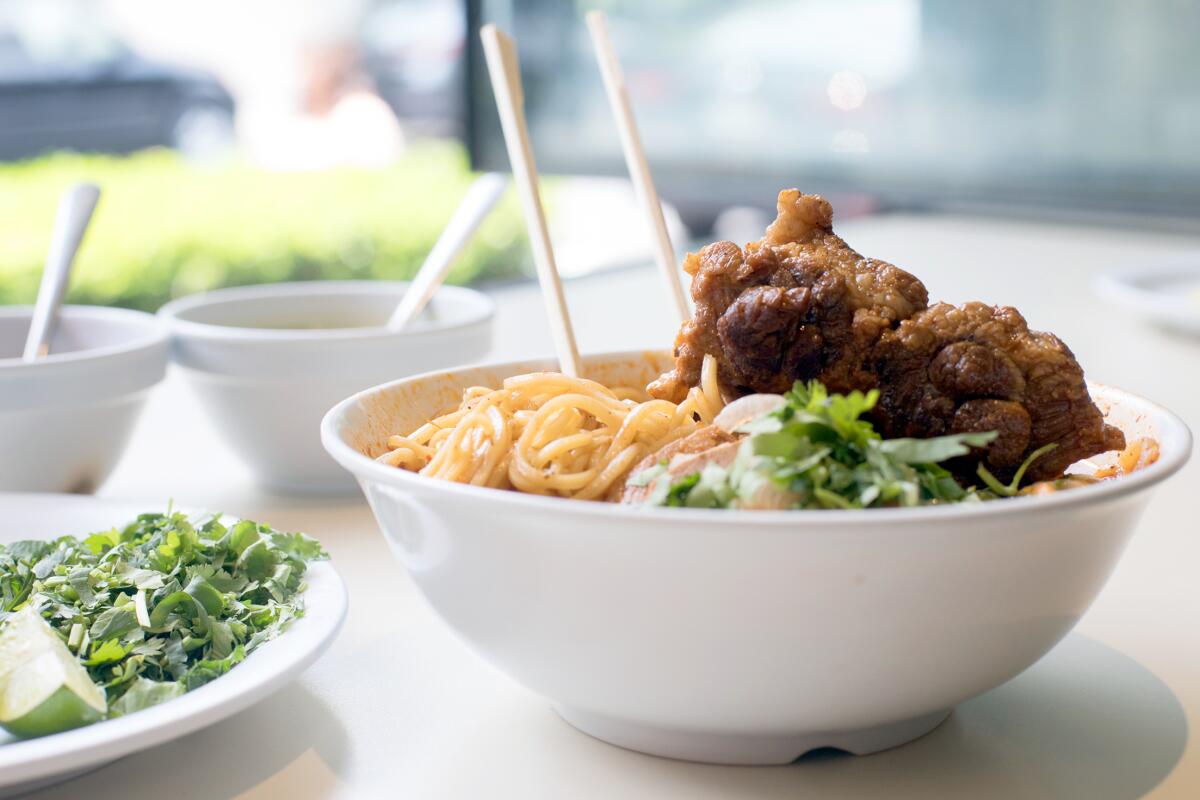Birria and ramen. It just makes sense

- Share via
MEXICO CITY — Chef Antonio de Livier was in northern Baja doing consulting work for a farm four years ago when he had a flash of insight.
“We had this great lamb, I started doing birria with the lamb, and then I threw noodles in it because I wanted noodle soup,” he said. “I loved the alkaline noodle and how it reacted to a very spicy broth, but with allspice and cinnamon and chiles and different Mexican ingredients.”
That birria-ramen, which De Livier calls birriamen, is now the centerpiece at Animo, his burgeoning Mexico City restaurant chain.

Newsletter: Sign up for the Tasting Notes newsletter
A soup-based business model for a culinary establishment seemed, at the outset, to be a preposterous move — few others were doing it in Mexico City, and De Livier knew that in order for the business to survive in the megalopolis, he would have to offer something singular.
Birriamen became that calling card.
The road to a bowl of birriamen is a time-consuming, craft-centered process, reminiscent of the hours that go into making a bowl of pho.
Although his original version was made with lamb, De Livier settled on birria de res for his restaurant birriamen for mass-market appeal. He begins his day by cooking beef tongue, oxtail and a bit of lamb to create what he says is “not a brodo, not a soup, but a broth.” He then adds chiles and spices before moving on to the adobo. The first broth takes about six hours to make; the birria about four. The ramen noodles are sourced from a shop three blocks away and made fresh daily.

The lengthy process has its share of challenges, and sourcing quality ingredients in particular has been an issue, said De Livier, who also runs an escabeche restaurant in Guadalajara and was previously a chef at a Cabo San Lucas hotel chain.
“We live in a huge city and use big quantities,” he said, “and sometimes things happen that you can’t control.”
Birria de res Zacatecas-style has a long presence in Southern California but gets served at few restaurants.
For instance, occasionally the beef has been frozen and then thawed before being delivered, a process that he said corrupts the quality of the final dish. Unfortunately, there’s no way to know if the beef was previously frozen until De Livier can taste-test the broth. If it turns out that’s the case, he has to start all over.
The noodle soup — which costs 84 pesos, or less than $5 — that finally hits the customer’s table is the culmination of more than nine hours of stewing and cooking and preparation. The broth and noodles are topped with thin slices of brisket; cilantro, onion and lime are available as add-ons.

The success of the noodles — De Livier sells around 350 bowls a day — has allowed him to expand Animo to three locations in the city. The restaurants also sell soups, tacos and other items, but birriamen makes up about 40% of the business.
Mexico City’s Asian food scene has become, in recent years, robust. In Zona Rosa, Korean BBQ comparable to that of L.A.’s Koreatown is readily available; in Centro Historico, Chinese buffets dot every other block; in Condesa, Japanese ramen is wildly popular. Has the city’s comida oriental influenced the flavors of De Livier’s dish?
“The ramen scene in Mexico City is everywhere, but I think I’ve only been to two of them,” De Livier said. Birriamen “was not necessarily made to look like an Oriental ramen, per se. It was not driven by me going out to get some ramen; I just wanted amazing food.”
Indeed, birriamen is a distinctly Mexican creation that just so happens to have ramen noodles in it. He has experimented with a few other Mexican-Japanese flavor combinations, such as udon noodles in a black bean broth with Napa cabbage, roasted pork belly, pickled squash and yellow chiles.
But the hybrid creations have to be balanced and make sense, De Livier said. “It’s not just to look cute and put noodles on every Mexican soup.”
More to Read
Eat your way across L.A.
Get our weekly Tasting Notes newsletter for reviews, news and more.
You may occasionally receive promotional content from the Los Angeles Times.









